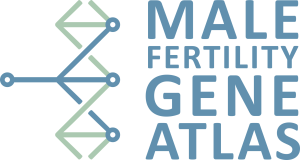Heterozygous loss-of-function SMC3 variants are associated with variable growth and developmental features
Ansari M, Faour KNW, Shimamura A, Grimes G, Kao EM, Denhoff ER, Blatnik A, Ben-Isvy D, Wang L, Helm BM, Firth H, Breman AM, Bijlsma EK, Iwata-Otsubo A, de Ravel TJL, Fusaro V, Fryer A, Nykamp K, Stühn LG, Haack TB, Boone PM, 11.04.2024
Abstract
Heterozygous missense variants and in-frame indels in SMC3 are a cause of Cornelia de Lange syndrome (CdLS), marked by intellectual disability, growth deficiency, and dysmorphism, via an apparent dominant-negative mechanism. However, the spectrum of manifestations associated with SMC3 loss-of-function variants has not been reported, leading to hypotheses of alternative phenotypes or even developmental lethality. We used matchmaking servers, patient registries, and other resources to identify individuals with heterozygous, predicted loss-of-function (pLoF) variants in SMC3, and analyzed population databases to characterize mutational intolerance in this gene. Here, we show that SMC3 behaves as an archetypal haploinsufficient gene: it is highly constrained against pLoF variants, strongly depleted for missense variants, and pLoF variants are associated with a range of developmental phenotypes. Among 14 individuals with SMC3 pLoF variants, phenotypes were variable but coalesced on low growth parameters, developmental delay/intellectual disability, and dysmorphism, reminiscent of atypical CdLS. Comparisons to individuals with SMC3 missense/in-frame indel variants demonstrated an overall milder presentation in pLoF carriers. Furthermore, several individuals harboring pLoF variants in SMC3 were nonpenetrant for growth, developmental, and/or dysmorphic features, and some had alternative symptomatologies with rational biological links to SMC3. Analyses of tumor and model system transcriptomic data and epigenetic data in a subset of cases suggest that SMC3 pLoF variants reduce SMC3 expression but do not strongly support clustering with functional genomic signatures of typical CdLS. Our finding of substantial population-scale LoF intolerance in concert with variable growth and developmental features in subjects with SMC3 pLoF variants expands the scope of cohesinopathies, informs on their allelic architecture, and suggests the existence of additional clearly LoF-constrained genes whose disease links will be confirmed only by multilayered genomic data paired with careful phenotyping.
Ansari M, Faour KNW, Shimamura A, Grimes G, Kao EM, Denhoff ER, Blatnik A, Ben-Isvy D, Wang L, Helm BM, Firth H, Breman AM, Bijlsma EK, Iwata-Otsubo A, de Ravel TJL, Fusaro V, Fryer A, Nykamp K, Stühn LG, Haack TB, Korenke GC, Constantinou P, Bujakowska KM, Low KJ, Place E, Humberson J, Napier MP, Hoffman J, Juusola J, Deardorff MA, Shao W, Rockowitz S, Krantz I, Kaur M, Raible S, Dortenzio V, Kliesch S, Singer-Berk M, Groopman E, DiTroia S, Ballal S, Srivastava S, Rothfelder K, Biskup S, Rzasa J, Kerkhof J, McConkey H, Sadikovic B, Hilton S, Banka S, Tüttelmann F, Conrad DF, O'Donnell-Luria A, Talkowski ME, FitzPatrick DR, Boone PM. Heterozygous loss-of-function SMC3 variants are associated with variable growth and developmental features. HGG Adv. 2024 Apr 11;5(2):100273. doi: 10.1016/j.xhgg.2024.100273
Publication: https://doi.org/10.1016/j.xhgg.2024.100273
 Disclaimer
Disclaimer
The publication Heterozygous loss-of-function SMC3 variants are associated with variable growth and developmental features by Ansari M, Faour KNW, Shimamura A, Grimes G, Kao EM, Denhoff ER, Blatnik A, Ben-Isvy D, Wang L, Helm BM, Firth H, Breman AM, Bijlsma EK, Iwata-Otsubo A, de Ravel TJL, Fusaro V, Fryer A, Nykamp K, Stühn LG, Haack TB, Boone PM is published under an open access license: http://creativecommons.org/licenses/by/4.0/. Permits non-commercial re-use, distribution, and reproduction in any medium, provided the original work is properly cited.
Curation by the MFGA team Relevant data sets presented in the publication have been identified. If possible, annotations (title, general information, conditions, processed tissue types and processed cell types) have been added based on information from the publication. Data tables and images that provide a good overview on the publication's findings on the data set have been extracted from the publication and/or supplement. If not stated otherwise, images are depicted with title and description exactly as in the publication. Tables have been adjusted to the MFGA table format. Conducted adjustments are explained in the detailed view of the tables. However, titles and descriptions have been adopted from the publication.
Data set 1: Potential explanation for the existence of mildly affected individuals with LoF variants
Exome: Whole Exome Sequencing
Species
| Species |
|---|
| Human |
Conditions
| Human phenotype ontology | Participants | Comment |
|---|---|---|
| HP:0011961: Non-obstructive azoospermia | 1000.0 | Absence of any measurable level of sperm in his semen, resulting from a defect in the production of spermatozoa in the testes. This can be differentiated from obstructive azoospermia on the basis of testicular biopsy. |
| HP:0000798: Oligozoospermia | Reduced count of spermatozoa in the semen, defined as a sperm count below 20 million per milliliter semen. | |
| HP:0030974: Cryptozoospermia | A type of oligozoospermia in which spermatozoa can be detected in an ejaculate only after centrifugation and inspection of the pellet. |
